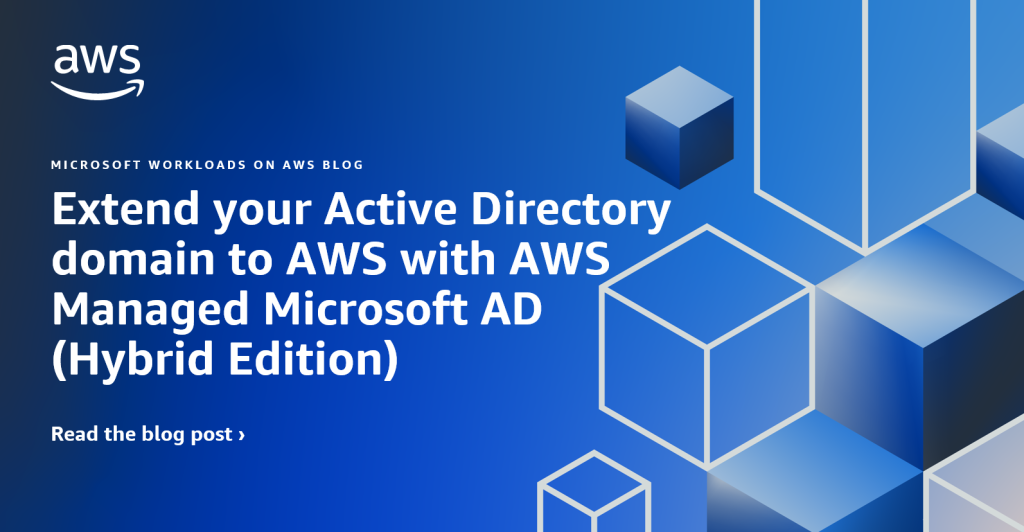Microsoft Workloads on AWS
Category: Thought Leadership
Reduce Microsoft SQL Server High Availability costs running on Amazon EC2
AWS has helped hundreds of thousands of customers transition their SQL Server workloads to the cloud since 2008, longer than any other cloud provider. Running business-critical applications often requires Microsoft SQL Server databases to be highly available. Customers choosing to use SQL Server for their mission-critical workloads can achieve high availability by deploying SQL Server […]
Optimize CPUs best practices for SQL Server workloads – continued
In this blog post, we will extend the analysis of the Optimize CPUs feature provided in a previous publication to other Amazon Elastic Compute Cloud (Amazon EC2) instances suitable for deployment of Microsoft SQL Server workloads on the Amazon Web Services (AWS) Cloud. Amazon EC2 now allows customers to modify an instance’s CPU options to […]
Extend your Active Directory domain to AWS with AWS Managed Microsoft AD (Hybrid Edition)
Introduction Today, we are announcing the general availability of the Hybrid Edition of AWS Directory Service for Microsoft Active Directory (AWS Managed Microsoft AD). This new edition lets you extend your existing self-managed Active Directory (AD) domain to AWS Managed Microsoft AD while preserving your current identity and access infrastructure. AWS Managed Microsoft AD (Hybrid […]
Testing 3-tier Windows app resilience on AWS with Resilience Testing
Resilience testing has emerged as a critical practice for organizations seeking to build and maintain resilient cloud applications. As environments grow more complex, more comprehensive testing methods become necessary. Resilience testing principles can be applied to Windows workloads on AWS to create controlled experiments that test system behavior under stress. These experiments can help you […]
Integrate multiple identity providers with AWS IAM Identity Center using Okta
In this blog post we will guide you on how to use Okta as an identity hub to integrate multiple identity providers with AWS IAM Identity Center. This approach provides users with a consistent authentication experience, enhances security, and simplifies administration. Introduction In today’s rapidly evolving business landscape, enterprises face the complex challenge of managing […]
Join AWS at PASS Data Community Summit 2024
AWS is excited to announce our participation as a Platinum sponsor at the PASS Data Community Summit 2024, continuing our commitment to empower organizations with our data and AI services. Our mission is to help businesses migrate, optimize, and modernize Microsoft SQL Server workloads while accelerating innovation, offering unrivaled reliability, security, and cost efficiency—all within […]
Streamline Identity Management with AWS Directory Service and One Identity Active Roles
In this blog post we will explore several scenarios where combining AWS Managed Microsoft AD and Active Roles can streamline and accelerate your AWS workload implementations. Many organizations rely on Microsoft Active Directory (AD) to manage identities and access controls, and extending AD infrastructure to the cloud is a common goal. This need often arises […]
New research shows AWS is the cloud provider of choice for SQL Server
A 2024 IDC Infobrief – Running SQL Server Workloads in the Cloud – reports that a clear majority of Microsoft SQL Server users chose AWS as their primary cloud provider when polled. In fact, data shows AWS is the top cloud provider of choice (52%) – more than the next six cloud providers combined. Figure […]
Make SQL Server end of support the start of your AWS cloud journey
Let’s face it. End of support (EOS) –three words that can unsettle any IT professional– is the last thing you want to hear about for your mission-critical applications. It creates additional work for you to deal with the upgrades and causes downtime for your end users. The Microsoft Windows Server and SQL Server end of […]
Optimize CPU best practices for SQL Server workloads
In this blog post, we will review the Amazon Elastic Compute Cloud (Amazon EC2) Optimize CPU feature and provide guidelines for utilizing this feature to reduce Microsoft SQL Server license cost on Amazon Web Services (AWS) without sacrificing SQL Server performance. 1. Introduction Amazon EC2 offers a diverse range of instance types tailored to suit […]









